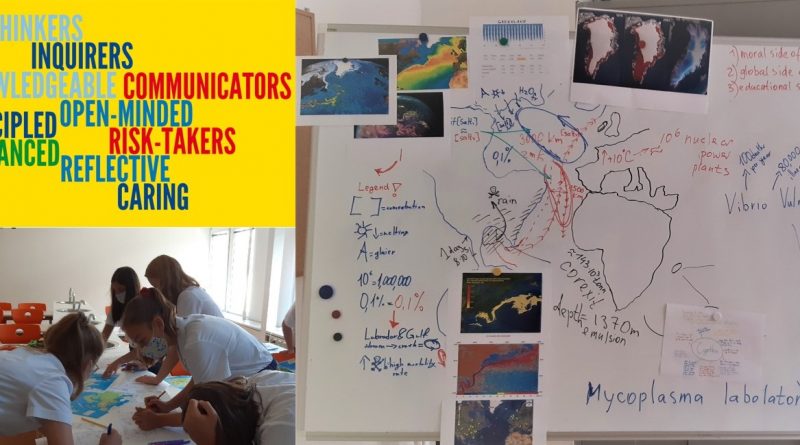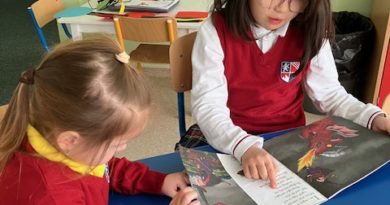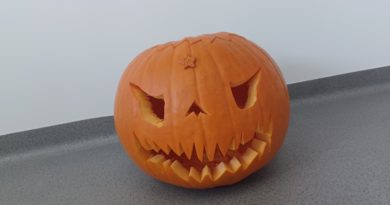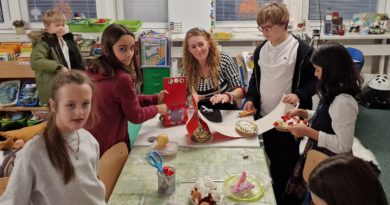EISB Science approaches to Disaster in the Gulf of Mexico & the Gulf Stream
In September this year, together with students of MYP 3, 4 and partly MYP 5, we began to study the problem of global climate change on our planet. It is clear that there are many reasons for these changes. The first object of our research was the disaster in the Gulf of Mexico in April 2010 and its consequences for the Gulf Stream and the planet as a whole. The students took this issue seriously. We discussed this problem for several lessons, finding information on the Internet, discussing, putting forward hypotheses, establishing cause-effect relationships and gaining new knowledge. With each lesson, their understanding of the causes and consequences of the disaster deepened. The result of this research was the first essay by students. Reading them, I feel a sense of pride for our guys. As I analyzed these essays, associations with the IB student profile attributes constantly came to my mind: Inquirers, Knowledgeable, Thinkers, Principled, Open – minded, Risk – takers, Reflective… All of these characteristics seemed to be written exclusively about our students. Need proof?
“Inquiry” means that students develop their skills for inquiry and research. Do our students know how to ask the right questions? “The Gulf Stream is weakening, getting colder and changing direction. Is it possible for the Gulf Stream to get so weak that it would stop flowing? What are the main reasons the Gulf Stream is weaker? Did we destroy the Gulf Stream even more while we tried to save it? What kind of information is needed to know and try preventing the consequences from happening?” (Tamara). “What is happening with the Gulf Stream today?”(Nina). “Why did this explosion happen? Who was interested in this? Is it moral to use very toxic substances?”(Alexandra).
To answer these and many other questions, we required knowledge of many sciences. So our students began to improve their “knowledgeable” skill in various fields.
Geography. “We have two types of ocean currents. The first ones are surface currents. These currents are mostly created and driven by the global wind system and by the Coriolis effect. The second type are deep water currents.”(Ema).
Physics. “Warm water has a lower density and rises to the surface. Cold water has a higher density, so it sinks to the bottom. Polar ice is composed of fresh water. When it melts, it adds more fresh water into the sea making the water in the North Atlantic less dense.”(Nina).
Chemistry. “Formation of sea ice further increases the salinity and density, because salt is ejected into the ocean when sea ice forms…”(Alexandra).
Marine biology. “Dolphins were ill and had liver disease which sometimes ended up fatal, pneumonia, loss of teeth and more.”(Denis). “82,000 birds, 6,165 sea turtles, and 25,900 marine mammals, including bottlenose dolphins, spinner dolphins, melon-headed whales and sperm whales were killed.”(Rojin).
Ecology. “780,000 cubic meters of oil was spilled causing it to burn, and emit dangerous carbon dioxide gasses to be emitted into the air, causing the infamous greenhouse effect and global warming.”(Viktor).
Medicine. “People also got infected by swimming in the sea or even if the infected rain touched their skin. They all have gotten respiratory and skin problems on which they all died after some time had passed. In other words: It slowly killed them.”(Nina). “This explosion caused a lot of health damages such as organ damages mostly because of the deadly bacteria, Cynthia and corexit.”(Arghavan).
Genetics. “During this time, a group of private scientists started to experiment with making bacteria with the least amount of genes to make a survivable organism. This bacteria got released due to unknown reasons started to travel across the currents, and it has evolved into a flesh eaten organism that thrives on the east coast of America.”(Viktor). “They invented Cynthia. Cynthia is a bacteria, that was programed to eat oil.”(Viktoria).
Politics, economics (business & finance). “One theory is that they purposely made this bacteria and made it seem that they didn’t know the consequences it in real life they knew them and even developed a antiserum for Cynthia, which they would sell for tons of money if he situation got out of hand.”(Tamara). “The CEO’s of big companies with chemicals were interested because they could get some big money for trying to clean the oil.”(Viktoria).
By processing a large amount of information, our students learn to be “Thinkers”. “…the oil industry in bad. It is bad in many ways but we can categorize it into two main ones: it is unsustainable and it is harmful to the environment.”(Tamara). “I consider this situation to be really difficult to maintain. If BP didn’t use cost cutting measures, the oil rig would not explode and it would cause the world this preposterous situation. I consider the fine of 18.2 billion dollars to not be a justifiable amount of money for how much trouble it caused.”(Viktor). “The reason is that the number 0.01% is the difference in density between the two strongest and the most important currents The Gulf stream and Labrador. If the number fall to 0.00% the weather all around the world will go crazy.”(Ema).
By processing a large amount of information, our students also learn to be “Principled”. “…the main causes of damage were petroleum toxicity, oxygen depletion and the last one is use of COREXIT for cleanup.”(Parnian). “But using the bacterium and the dispersant was very irresponsible due to the damage it has caused which was a thousand times worse than the oil itself. But was it really unexpected that that would happen? The scientists definitely knew what would happen if they released the corexit dispersant into the water. They knew the damage it would cause would be much worse than the oil itself. But why?”(Nina).
In an effort to understand what has happened and is happening in the world, our students learn to be “Open-minded”. “We would need to collect more data about the Deepwater Horizon explosion and understand the topic into the depths to further understand the need of Cynthia and corexit. On these “weapons” we’d need more research to come up witch all the problems it has caused and collect a wider range of data. More data would be needed about the Gulf Stream itself and exactly how quickly it is slowing down, moving towards Europe and examine how much less water it carries now than it used to.”(Tamara).
Today our boys and girls are only students, but they are already ready to take part in solving the global problems of mankind, they are ready to be “Risk-takers”. “If I were to solve the problem of the Gulf Stream disappearing, I would first have to stop the Greenland glaciers from melting. Due to the melting ice in Greenland, the concentration of salt is lower. Because of this change in the water density, the Gulf Stream and the Labrador current will collide causing them both to change their directions and flowing in circles unable to move past each other.”(Nina). “I know how to analyze the possible consequences of the oil spill but I don’t think I know how to predict them.”(Denis).
By studying what is happening in the world, our students are aware of the consequences. “…there would be so much pollution in this area and the people would have not drinkable water because of the toxic pesticides in the water due to what happened in the explosion and after it.”(Rebeka). “And while the east coast of America and Western Europe get chilly in their Ice Age, temperatures in the rest of the world would keep rising. Climate change would trigger fires, tsunamis, hurricanes – all at the same time.”(Alexandra). “Fixing this problem will cost a lot of money, that not only, a single country won’t fix, but the whole world must get together to keep the ice caps in Greenland from melting, to get the poisonous oil out of the streams.”(Viktor). “What have we learned or can learn from this? That people do not care about each other all they care of is money. And people most of the time do not think of the consequences that might come. We should be careful with technologies because it may turn the wrong way in the end.”(Viktoria).
After reading all these quotes from student essays, I think you will agree with me that EIS students are thinkers, researchers. They have a great desire to learn about the world, to solve existing problems, and not create new ones. Our students have a lot of creativity. They have powerful wings because they were born to fly. Let’s help them with this.




